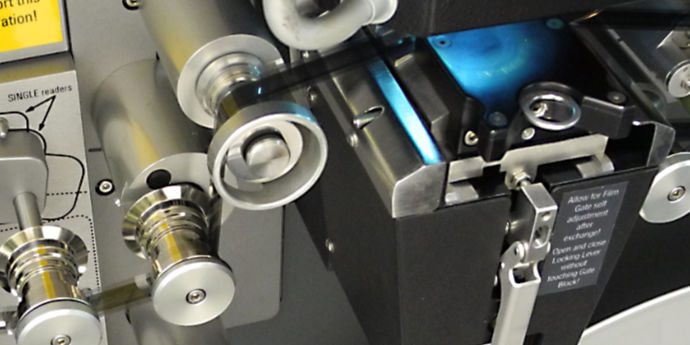In early 2018 I was contacted by a former viewer and one-time audience member of The Tarax Show, Rob Grant, who is Senior Video Producer at the Royal Children’s Hospital Creative Studio in Melbourne. He had stumbled across this Film Restoration Diary blog while researching scanning solutions for the hospital’s 16mm film archive.
I was able to visit Rob at the RCH and see first hand the diverse and important work done at the hospital’s Creative Studio. In preparation for the 150th anniversary in 2020, the Creative Studio had the task of creating displays chronicling the history of the hospital. This included scanning and digitising their collection of 16mm films which dated back to the 1940s.
Cameraquip and the Golden Eye Scanner
Rob Grant had found a high quality film scanning service offered by Cameraquip in South Melbourne. Best known as a professional camera equipment rental business, Cameraquip had acquired a Digital Vision Golden Eye scanner — that’s the same Digital Vision whose Phoenix software was mentioned in the previous post.
Rob arranged a visit to Cameraquip where I met Malcolm Richards, the founder of Cameraquip, and was able to see the Golden Eye scanner in operation and talk with Malcolm about their experience with it.
Before going any further, I should also mention that Malcolm has on display in his foyer an amazing collection of 16mm and 35mm professional movie cameras — everything from classic Hollywood style cameras, such as a 35mm Mitchell with blimp, through many models of Arriflex, some Auricons, Bolex, B&H, and small handhelds. This collection caught my attention and must surely be rather unique.
Malcolm’s scanner is a Golden Eye Mark II model which is about seven years old (the current model Golden Eye is the Mark IV — the Mark II does 2K, the Mark IV does 4K).

A Better Line Scanner
Contrary to my expectation, the Golden Eye is a line scanner — i.e. the scan is constructed from a series of individual scan lines captured sequentially as the film moves through the scanner, rather than capturing a full frame all at once.
The Spirit Datacine, mentioned earlier in this blog, is also a line scanner, and scans done on the Spirit had suffered from the following problems:
-
Film containing traditional cement splices caused speed instabilities, resulting in “splice bumps” in the resulting scan.
-
Subtle variations of the film speed through the scanner (“flutter”) caused vertical “squash/stretch” artefacts in the scanned frames as the scan lines were pushed closer together or stretched further apart.
-
Inability to scan shrunken or warped film due to sprockets in the film handling path. The fixed spacing of the sprocket pins was not compatible with the spacing of the holes on the shrunken film.
Malcolm assured me that the Golden Eye has not exhibited these problems. The Golden Eye has a special secondary camera to optically register frames using sprocket holes (the same system used on the full-frame Lasergraphics Scan Station scanner used for scanning two Tarax Show pantomime reels which had failed to scan satisfactorily on the Spirit Datacine — see the an earlier blog post). The Golden Eye can also be run without sprockets in the film path if necessary.
In the next post we will take a closer look at the Golden Eye scanner.
